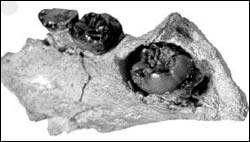Earliest Evidence Of Hereditary Genetic Disorder

View of the lower jaw of the prehistoric child from Ethiopia, showing the tooth at left with abnormal shape resulting from amelogensis imperfecta.
The discovery of what is believed to be the oldest evidence yet found of a human hereditary genetic disorder has been announced by researchers at the Hebrew University of Jerusalem.
The researchers are Dr. Uri Zilberman and Patricia Smith, the Joel Wilbush Professor of Medical Anthropology, both of the Faculty of Dental Medicine of the Hebrew University and Dr. Silvana Condemi a senior researcher at the French Research Institute in Jerusalem. They are among the authors of an article in the June issue of the Journal of Human Evolution that details the finding of a disease known as amelogenesis imperfecta in the teeth of a fossil found in archaeological excavations in Ethiopia. The fossil is dated as 1.5 million years old and is from a two-year-old Homo erectus child. Homo erectus was a precursor of modern man.
According to Dr.Zilberman, this is the first recorded evidence from such an early prehistoric period of a hereditary disorder in which the specific genes responsible have been identified. Undoubtedly, he said, there are other hereditary diseases that have come down to us from prehistoric ancestors and which are yet to be discovered in fossil remains.
Amelogenesis imperfecta is a hereditary disorder that manifests itself in tooth enamel that is abnormal in structure, low in mineral content and hence subject to rapid wear and chipping. The Hebrew University researchers confirmed the clear presence of the disease in the fossil sample through x-ray and scanning electron microscope analyses. The disease appears relatively rarely today (one in 14,000 people in Israel, one in 8,000 in the U.S.). It is much more common in one area of Sweden (one in 700).
Dr. Zilberman and Prof. Smith are paleoanthropologists in the Laboratory of Bioanthropology and Ancient DNA at the Hebrew University Faculty of Dental Medicine.
Also among the authors of the article in the Journal of Human Evolution is Prof. Marcello Piperno of the University of Rome.
Media Contact
More Information:
http://www.huji.ac.il/huji/eng/index_e.htmAll latest news from the category: Life Sciences and Chemistry
Articles and reports from the Life Sciences and chemistry area deal with applied and basic research into modern biology, chemistry and human medicine.
Valuable information can be found on a range of life sciences fields including bacteriology, biochemistry, bionics, bioinformatics, biophysics, biotechnology, genetics, geobotany, human biology, marine biology, microbiology, molecular biology, cellular biology, zoology, bioinorganic chemistry, microchemistry and environmental chemistry.
Newest articles

Silicon Carbide Innovation Alliance to drive industrial-scale semiconductor work
Known for its ability to withstand extreme environments and high voltages, silicon carbide (SiC) is a semiconducting material made up of silicon and carbon atoms arranged into crystals that is…

New SPECT/CT technique shows impressive biomarker identification
…offers increased access for prostate cancer patients. A novel SPECT/CT acquisition method can accurately detect radiopharmaceutical biodistribution in a convenient manner for prostate cancer patients, opening the door for more…

How 3D printers can give robots a soft touch
Soft skin coverings and touch sensors have emerged as a promising feature for robots that are both safer and more intuitive for human interaction, but they are expensive and difficult…





















